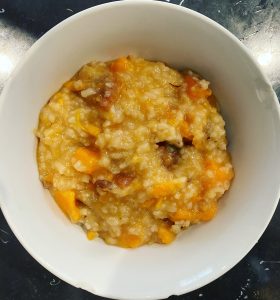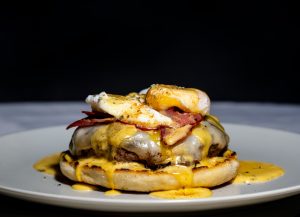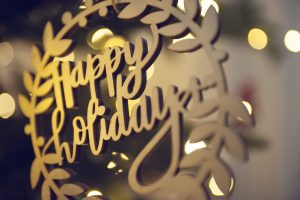Acupuncture
Does Acupuncture Treat Heart Disease?

According to the Centers for Disease Control and Prevention, heart disease is the leading cause of death for men and women in the United States. And ethnicity doesn’t matter, as people of all racial and ethnic groups are impacted. With such serious statistics, many might wonder what treatment options are available. Did you know that acupuncture can help with treating heart disease, as well as many of its contributing factors? Read on to learn how. continue reading
Sweet Potato Congee for Winter
 Happy New Year, all! As we continue through one of the worst cold and flu seasons in recent memory, 2020 notwithstanding, I’ll begin with a recipe.
Happy New Year, all! As we continue through one of the worst cold and flu seasons in recent memory, 2020 notwithstanding, I’ll begin with a recipe.
Sweet potato congee with red dates, honey added if desired (and who won’t?):
1 large chopped sweet potato
1 cup of rice, rinsed please
8 cups of water
10-30 grams of red dates sliced open (closer to 10g if you have a “damp heat” body type or pathology—closer to 30g if you are the frail and pale type with tendency to insomnia and/or heart palpitations).
Bring to boil and simmer uncovered for about 40 minutes, or until the consistency is as above, like a porridge. In Asia most people take it a bit more watery than this, but either way is fine. Plate and drizzle honey on top to taste.
Although white rice is mostly vilified by Western dietitians, in Eastern Medicine we believe that the gentle support it provides to the internal organs is imperative for optimizing the absorption of all accompanying ingredients, also at generating the healthy stomach fluids needed for digestion. Without strong metabolism we cannot build blood or create nutrients. Without blood we cannot live—more relevant, with subjectively deficient blood all of our parasympathetic functioning may weaken and we may flirt with anemia.
If you are strongly averse to (white) rice, you can absolutely try making this with quinoa, millet, or farro. Risotto or orzo, unfortunately, will not work.
The Eastern Medical diet is somewhat diametrically opposite to that of raw vegans. Besides encouraging at least small amounts of animal protein, we believe the best way to optimize health is through low, slow, and long cooking of foods to extract all nutrients into the dish and make them easy for our guts to process. Anything cold or damp, such as ice, sugar, or alcohol should at least wait until after the food has been consumed and processed for at least 15-30 minutes whenever possible. Which means all of our mothers were correct in echoing the concept of not “spoiling our dinner” by having sweets first. The adult parallel to this might be cautioning to limit drinks before dinner.
Sweet potatoes are an excellent “tonic” for the stomach qi in Winter, and red dates are actually one of the most important herbs in all of Chinese Medicine, appearing in a large percentage of classical formulas, with the intention of protecting the healthy stomach fluids and nourishing blood of the heart. I recommend making this recipe, storing leftovers in the fridge, and eating 2-3 times a week in winter. To reheat just add plenty of water to keep consistency.
Hope all are warm and healthy!
Benefits of Adding Acupuncture to Your Wellness Routine

This is the time of year when many are looking to start (or restart) their wellness routines. Self-care Saturdays may have fallen by the wayside during the holiday season and now is the time to get back on track. As you examine your health goals and wellness priorities this year, have you considered adding acupuncture to your wellness routine? If not, here’s why you should and some things to consider to set yourself up for success.
Acupuncture provides numerous health benefits from a holistic approach to wellness. It’s a non-pharmacological approach to health and wellness and addresses a variety of health concerns you might be struggling with. continue reading
What are We Actually Craving, in Our Cravings?
 Why do many women crave chocolate or dairy more while on their menses? Why do men generally crave beer more than women? Why do some people crave sweets more at night, or wake up in the morning feeling everything from ravenous to having no appetite at all? And how do these tendencies influence future tendencies within our bodies?
Why do many women crave chocolate or dairy more while on their menses? Why do men generally crave beer more than women? Why do some people crave sweets more at night, or wake up in the morning feeling everything from ravenous to having no appetite at all? And how do these tendencies influence future tendencies within our bodies?
Western medicine has no clue—“some people are just like that,” they shrug, or my personal favorite: “That’s normal (as you get older).” Without an intricate understanding of the paradigm of internal (Chinese) medicine, unique preferences and/or habits can be difficult to explain, hence impossible to change.
“I just have a sweet tooth,” people say, which is an expression. What if your will power was not entirely psychological, but partially a result of the state of your internal organs, making it much harder for you to resist temptation than others?
Dryness is an epidemic. It stands to reason in a society that over-prioritizes the yang, masculine energy. While yin is represented by rest, stoppage, sleep, coolness and moisture, yang is work, working out, going out, staying out late, everything out; burning it at all ends, not to mention excessive caffeinated diuretics and overly seasoned or spicy foods.
In Chinese Medical terms stress “depletes the healthy body fluids,” as do NSAIDS, most meds, skipping breakfast, poor sleep, overwork, over-working out, or excessive masturbation. Unfortunately, these are not fluids that can be supplemented through hydration. While it’s great to hydrate, from our perspective this loss is of metabolic/organ fluids that can be restored only through proper rest, herbal medicine, and diet, namely eggs and red meat.
In the meantime, whether consciously or not, we are all craving the ultimate yin. Think breastfeeding: An opportunity to stop everything, be comforted and nuzzled by some soft, fatty, support structure, nourished by its sweet, thick, delicious juice. Since few of us have that opportunity, we opt instead for ice cream or cheese, boba tea, or some delectable hazy IPA—anything thick, sweet, and nurturing in lieu of the adult version of nursing, which might be an early bedtime after a relaxing day. Imagine that. Do we deserve such a thing?
“Nighttime belongs to the blood,” is an expression in Classical Medicine that refers to our healthy body fluids being in charge of evening operations, whereas cellular energy and sympathetic manage the day hours. When a symptom, such as sweet cravings, is worse at night, it further confirms fluid deficiency as part of its etiology. What many women are craving during their cycle, is frankly, more blood. Most don’t have the opportunity to necessarily get more rest, eat more red meat or go to sleep earlier (though if you do, you should!). Instead, they reach for sweets and/or dairy to temporarily satiate the desire to supplement yin. Unfortunately, in doing so this creates more dampness in the microbiome, which makes it harder for the organs to then convert future foods into healthy nutrients, which causes more cravings, and so on. Healthier options for sticky, yin-nourishing substances might be nut butters, smoothies, non-dairy yogurts, or baked apples with some honey.
“Yin-nourishing herbs” are damp. I always think of the foxglove root, one of the most herbs in our pharmacopeia, which looks, but does NOT at all taste like a chocolate brownie. It is rare to meet a patient, man or woman, who does not need some amount of foxglove to supplement lost fluids; although it is even more rare to meet someone whose gut is ready for it. Foxglove is thick and heavy, like boba tea or breastmilk, so if someone has weak digestion, loose stools, acid reflux, etc. it is probably not ideal for them. It is important in our “moments of weakness” to access at least enough will power to reach for healthier alternatives enough of the time, so as to protect our gut health—so that one day our herbalist will give us the green light to truly nourish our yin organ fluids with brilliant substances like foxglove.
Happy Holidays, 2023!

When I reflect on my 2023 from a Chinese Medical perspective, I would characterize it as “yang within yin,” which refers to a condition being active and invigorating within an outward and/or greater context of pacification or lethargy. Think when we feel exhausted in the middle of the night but for some reason are unable to get back to sleep. This is internal “yang exuberance” during the most “yin time of day” when the rest of our body beyond our ruminating mind is logically tired, yin, wishing to sleep.
The dominant theme and stand-out defining occurrence of my past year has been becoming a first-time homeowner obviously, plus resuming my identity as a suburbanite for the first time in 27 years, which is over three “jing cycles” for a man! A “jing cycle” refers to our stages of physiological aging and spiritual evolution. Those of men are 8 years, those of women are 7, as the latter are supposed to mature faster.
27 years is so long ago that this of course does not feel like any kind of return or reunion, but an entirely new and foreign endeavor, heightened by the fact that I am no longer the dependent child, but instead have a dependent child myself.
“Settling down,” whether into marriage, parenthood, suburbia, or all three, has a yin essence. All three contexts are inherently more introverted, more grounding and isolating, even if one chooses yang within yin, and continues to prioritize community and socialization as we do.
Owning a home has an equally yin-nourishing nature. It represents stability. It might even be metaphorical, in that we are no longer floating high above on the third, tenth, or twenty-first floor of some building, relatively closer to the sun, which is the ultimate yang. Instead, we are on the ground. We are responsible for the ground and might reap its benefits, as in freely walking barefoot. Thus far my favorite perk is the town pool in Summer, located a ten-minute walk from home and seems to act as a predictable nucleus where we can cross paths with local friends. POOL=WATER=YIN. The raucous kids at the pool would be yang within yin.
Within this suburban yin of stability, which the majority of the population aspire to and view as the trophy for a first half of life well-lived, is the chaotic yang of constant repairs, occasionally necessary renovations, and great cost of resources, whether financial or physiological. Things have finally calmed down for us in this regard—the first 4-6 months were brutal—and we are grateful to have finally arrived at our new baseline of random windows or bathroom doors simply not shutting all the way. We’ll take it. It’s like after a serious illness gets cured most of us would be totally content with the occasional bout of acid reflux or low back pain.
Professionally, this year I completed my second 8-month long, virtual herbal medicine workshop with mentor, Dr. Suzanne Robidoux, in Beijing. Thus far she has been my most valued and enlightening teachers since starting school 15 years ago, and I look forward to studying more with her in the future. However, for 2024 my agenda is to take a break from her courses to dive deeper into studies of our most classic medical text, the Shang Han Lun, as well as the famous, Master Tung’s approach to acupuncture, taught by my Tai Chi teacher and friend, Dr. Henry McCann. That is, as much as house crises and repairs permit.
There are some ways in this incarnation of life where I have felt a bit unlucky, and other ways where I feel very lucky. I sincerely feel very lucky that people come to me for healing and trust me to stick needles in them, not always with the softest touch, and prescribe them herbal medicine, not always with the sweetest flavor. This especially speaks volumes in a society that hardly educates or encourages the public on Eastern Medicine at all. I recognize it as a testament to every one of my patients’ courage and open minds, which in my opinion are two of the most important characteristics to take with us through life. I thank you all for possessing these qualities, for coming to my office this year, and I hope to see you next!


